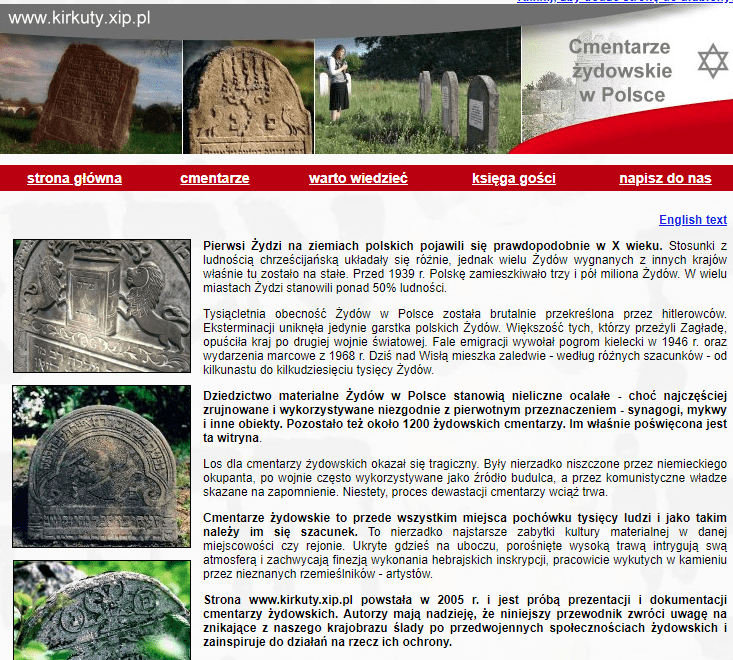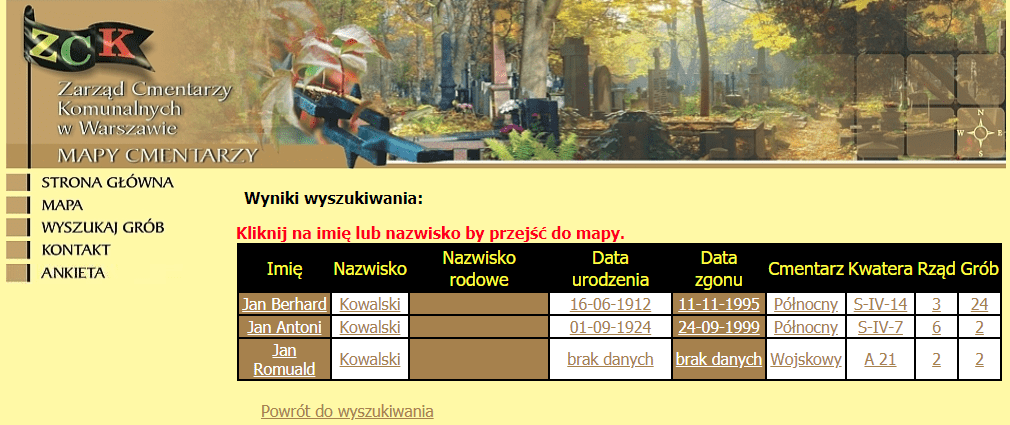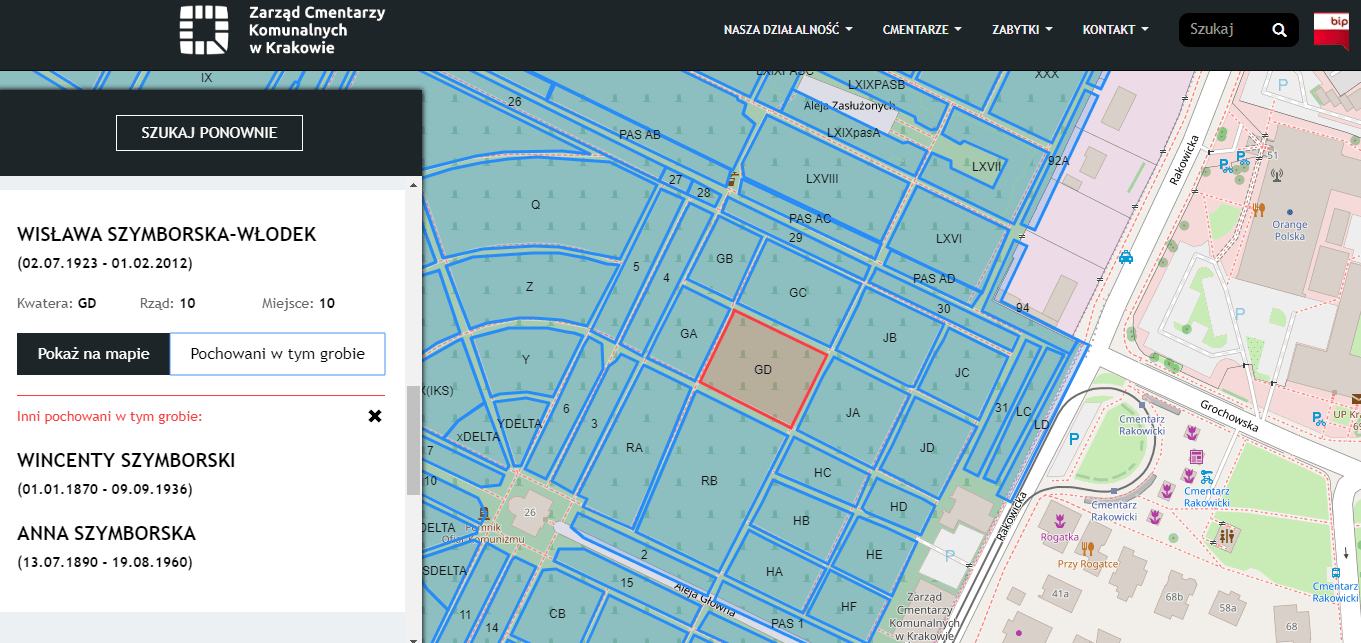November is fast approaching, which in our culture is a month of reflection, the time when we remember the deceased members of our families. Unfortunately, not everyone has the opportunity to visit the graves of their ancestors, light a candle and say a prayer. The problem is especially for those who live far beyond Polish borders, but not only!
Many of us do not know the exact burial place of our ancestors. Especially those who died during World War I and II, many also had to leave Poland and live abroad. In addition, some of our family graves are currently outside our country – in Ukraine, Belarus and Lithuania. We often don’t remember where the grave of our great-grandmother or great-grandfather is, even if we know at which cemetery they are buried. Hopefully in this situation, there are more and more online portals and databases that publish information about people who are buried on Polish cemeteries, photos of graves, and even give the opportunity to light a symbolic / virtual candle and leave contact information.
All – Poland databases
It is a nationwide search engine of people buried connecting to a database over 669 cemeteries across the all country. It combines information about the deceased with the place of their burial and often with a photo of the grave. The list of graves and those buried is constantly updated by the administrators of cemeteries. The search engine is simple and intuitive, in addition, search is also possible on the mobile version (Android).

After entering the first and last name, we get a map with the number of people matching the search conditions in the database. By clicking on a specific province we receive a list of cemeteries sending us to specific graves:

View of the page with the list of cemeteries from the Lesser Poland Voivodeship:

Page view after choosing the parish cemetery in Proszowice:

The view after selecting one of the records found:

In the example above, the database provides a lot of important information, we know what the tombstone looks like, thanks to which we know what grave we are looking for, we have a map with the location marked. Importantly, thanks to the portal we can find out if the grave is paid or report any errors in the information contained, but also light a virtual candle and leave a message to other virtual users searching for the grave.
It is a nationwide search engine for cemeteries, including indexes of the buried people. As previously described, it combines information about the deceased with the place of their burial and photographic tomb. Importantly, the database creates a set of separate subpages for each cemetery, which is why we conduct searches in the database separately for each of them. The database currently publishes information about 261 cemeteries and 653,000 buried people.
Home page view:

We can look for a cemetery on the website that interests us and use the map of Poland divided into voivodships (state administration) or dioceses (church administration).
Search engine view after selecting a specific subpage of the cemetery:

View of the subpage with the sought grave:

The database provides us with information about the person buried in a given grave, and thanks to the map and photos, it makes it easier to locate the grave.
View of the cemetery’s subpages:

The database provides a virtual walk around the cemetery, additionally presents information about distinguished people buried in the cemetery and refers to information about the institution that manages the cemetery.
This is another nationwide search engine for cemeteries and burials. Provides information on 753 cemeteries and over 600,000 burials.
Main page view:

- View of the search engine by name of the deceased : http://ksiegazmarlych24.pl/

Search results for the grave of Jan Kowalski:

We select the person we are looking for from the list. It is important that the database contains not only death dates, but also dates of birth, which allows you to more accurately assess whether the record found describes the person we are looking for. Of course, we must remember that the database does not contain information about all people buried at Polish cemeteries.
It is worth noting that there are also databases publishing information on denominational cemeteries, not only those of Roman Catholic faith. In Poland, the process of organizing and restoring Jewish cemeteries, largely destroyed during World War II and forgotten, has been under way in Poland for many years. Thanks to the efforts of the Jewish community of Polish origin scattered all over the world, but also of local communities and local authorities, Jewish cemeteries have been restored from oblivion as a testimony to the centuries-old presence of the Jewish population in the Polish lands, but above all a place where this community can remember and worship their ancestors.
Currently, there are about 1,200 Jewish cemeteries in Poland – the information about them can be found through the website:
Homepage view:

Local databases:
In addition to nationwide portals, there are many databases of this type of local nature, publishing information on the deceased buried in cemeteries in a particular town, or managed by a particular institution. Such databases are created primarily in large cities and operate e.g. in Warsaw or Krakow.
- Grave search engine created by the Board of Municipal Cemeteries in Warsaw: http://www.cmentarzekomunalne.com.pl/

The portal publishes information from three Warsaw cemeteries: Southern, Northern and Military. All you have to do is enter the name and surname in the search engine and you will receive information if someone has been buried in any of these three cemeteries.

By choosing one of the records, the database will show a map with the exact location of the grave, which in the case of such large cemeteries as Warsaw’s is a huge help.
In addition, when searching for information about a person who died in Warsaw, we can use the Warsaw obituary search engine, which contains obituaries published in the Warsaw press after II World War:
- Warsaw Obituaries: http://www.nekrologi-baza.pl/

Similarly to Warsaw, the Management of Municipal Cemeteries in Krakow also created a search engine for graves located at most of Krakow’s cemeteries.
- Graves locator in Krakow : https://zck-krakow.pl/locator

Using the database is easy if we know exactly which cemetery our ancestor was buried at. Select the cemetery from the list, then enter the details of the person you are looking for. If we do not know at which cemetery our ancestor’s grave is located, then we must select from the list each subsequent cemetery. In this case, I was looking for the grave of our Nobel Prize winner Wisława Szymborska:

In our search, it also happens that we do not know where our ancestor died, because it might have happened during the war in which he participated. Below you will find databases publishing information about military cemeteries come to our aid:
This database publishes information on soldiers killed during the Defense War in September 1939, contains over 22,000 records and indicates exactly where the war cemetery is located. In most cases, we will not find a name grave there, only a monument that commemorates all those killed in a skirmish or battle, or symbolic nameless crosses, but we can at least assume that in one of them our ancestor is buried.

The drama of World War II did not only concern soldiers, the repression by both occupiers was directed primarily at the civilian population. It is often the case that we do not know the fate of our loved ones, who were prisoners of concentration camps, forced laborers, prisoners of Gulags. In the search for those people, it is worth searching the information collected into two databases – created and published by the Institute of National Remembrance. It should be noted, however, that usually we will not find here information about the place of burial, but in many cases information about the date and place of death – which is already a lot.
The database publishes the results of many years of work of historians on establishing the name list of citizens of the Second Republic of Poland who were subjected to all kinds of repression by the German occupier in 1939-1945. Today, this list includes 4647298 names. Among these people there is a huge number of those who did not survive the war, perhaps there is also an information about the place of death of your family member.

This database is the result of the work of the Institute of National Remembrance and currently contains over 316 000 records about people repressed by the USSR before and during World War II.

The above databases give us many opportunities for searching, but we must remember that not all the graves of our ancestors survived to this day. Many factors could have influenced this situation. Whether there is still someone who looks after this particular grave, whether the cemetery site has been paid for a sufficiently long time, and even if the cemetery is still located at the burial site.
The cemetery is a limited space, if the grave in which our ancestor was buried was neglected, the time for which it was paid has long passed (usually the fee is paid for 25 years) it is highly probable that such grave was liquidated, and the remains of our relatives were transferred to mass grave located at this particular cemetery. It could also happen that subsequent generations of the family were buried at the burial place of our ancestors, but no one noted this procedure and the grave plate does not contain information about all the people buried in the place.
When looking for the graves of our relatives, we must also remember that most parish cemeteries did not keep registers of people buried there, or these registers have not survived to our times. The graves indexed and placed in the above mentioned databases do not contain all the burials that took place in the developed cemeteries, but only all of those that survived until the creation of the modern register. Therefore, on the one hand, the older the grave we are looking for, the less likely we will succeed. On the other hand, in many cemeteries the oldest graves are a kind of monuments, because of their artistic values, or because the person buried in it is considered important for local history and culture or in the nationwide dimension. Such graves are usually covered by conservation, and one of the ways to take care of these monuments is annual fundraising organized on our cemeteries.
When visiting the graves of deceased relatives this year, pay attention to the tombstones and the information that is there. Photograph them! Because it may turn out that there are important dates and facts that will help you move on in your genealogical search.
Text by Karolina Szlęzak
